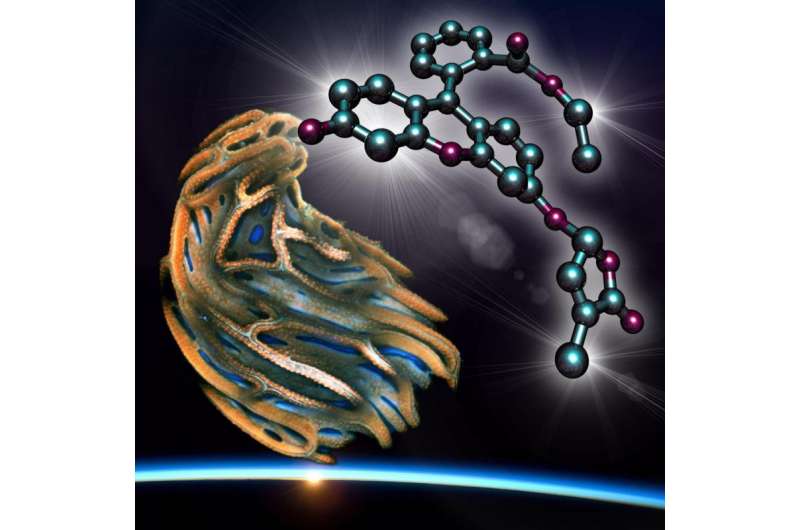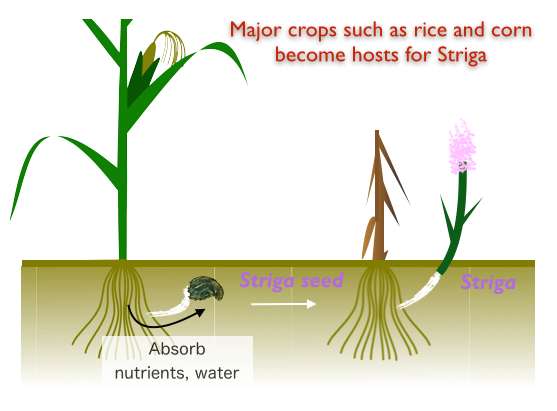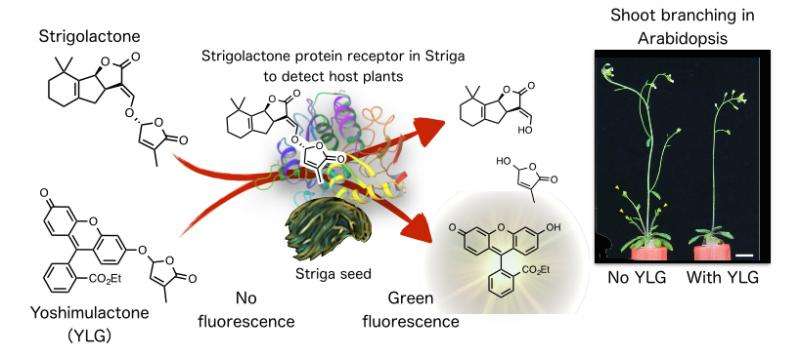The seed of striga and fluorescence turn-on probe for analyzing the germination of striga. Credit: Shinya Hagihara, ITbM, Nagoya University
(Phys.org)—In sub-Saharan Africa, few agricultural parasites are as devastating to a wide variety of crops as Striga hermonthica, commonly known as witchweed. It chokes out such staple crops as sorghum, millet and rice, which show symptoms similar to those of drought or soil nutrient deficiency.
One of the reasons Striga is so hard to control is that its symptoms do not become apparent until the parasite actually emerges from the plants, by which point it is too late to save the crop. Thus, it constitutes a major threat to African food security, and has led to the loss of an estimated U.S. $10 billion in production every single year. Establishing the regulatory dynamics of the parasite are thus of singular importance to researchers hoping to control or eradicate it.
Though the mechanisms of Striga propagation are still unclear, plant hormones called strigolactones, which are produced by the host plants, are known to stimulate the germination of striga. About 17 known strigolactones have been isolated, all unique to different plant species, and the striga parasite recognizes its host plants by sensing the composition of their strigolactones. In plants, strigolactones function as both plant hormones and as signals for communicating with microbes. Researchers have previously identified a group of proteins in crop plants as presumptive receptors for strigolactones, but the receptor in the Striga parasite remains unidentified.
Reporting in the journal Science, an international group of researchers has developed a fluorescence probe called Yoshimulactone Green (YLG), which activates strigolactone signaling and illuminates the signal perception activity of strigolactone receptors. The researchers hoped that it would elucidate the mechanisms of striga germination and eventually point toward a means of controlling infection and propagation.
The current study reports the development of the small-molecule probe designed to illuminate the function of strigolactone receptors. The researchers looked at the hydrolizing action of a known receptor called AtD14 and applied it to the development of YLG, a fluorogenic agonist for receptors of similar type. YLG was designed to be recognized by strigolactone receptors, and the resulting hydrolizing reaction leads to the generation of fluorescent products. Thus, the probe provides visual markers for strigolactone receptivity.
Striga infests crops by absorbing nutrients and water from their roots. Credit: ITbM, Nagoya University
The authors report that in vivo, YLG successfully stimulates Striga germination, and 97 percent of the germinating seeds emitted fluorescence. "Thus, YLG functions as a flurogenic agonist in Striga, which cleaves the ligand as it is perceived," they write. They subsequently searched a public database of Striga RNA sequences and identified 12 genes as candidate receptors related to the ArD14 receptor upon which they based the YLG probe.
By evaluating the relevance of hydrolysis in Striga evolution, they determined that 10 genes in the YLG-illuminated hydrolysis trait coincided with Striga characteristics, implicating them in seed germination. Of this subgroup, two showed "indiscriminately high affinity to all of the strigolactones tested." The authors write, "Thus, from a few promiscuous receptors, multiple specialized receptors seem to have evolved to detect structurally diverse strigolactones more efficiently. This would have led to each different strigolactone being perceived by a different combination of receptors."
Striga seeds are treated with Yoshimulactone, which show similar bioactivity to strigolactone. Credit: ITbM, Nagoya University
More information: "Probing strigolactone receptors in Striga hermonthica with fluorescence." Science 21 August 2015: Vol. 349 no. 6250 pp. 864-868 DOI: 10.1126/science.aab3831
ABSTRACT
Elucidating the signaling mechanism of strigolactones has been the key to controlling the devastating problem caused by the parasitic plant Striga hermonthica. To overcome the genetic intractability that has previously interfered with identification of the strigolactone receptor, we developed a fluorescence turn-on probe, Yoshimulactone Green (YLG), which activates strigolactone signaling and illuminates signal perception by the strigolactone receptors. Here we describe how strigolactones bind to and act via ShHTLs, the diverged family of α/β hydrolase-fold proteins in Striga. Live imaging using YLGs revealed that a dynamic wavelike propagation of strigolactone perception wakes up Striga seeds. We conclude that ShHTLs function as the strigolactone receptors mediating seed germination in Striga. Our findings enable access to strigolactone receptors and observation of the regulatory dynamics for strigolactone signal transduction in Striga.
Journal information: Science
© 2015 Phys.org

























